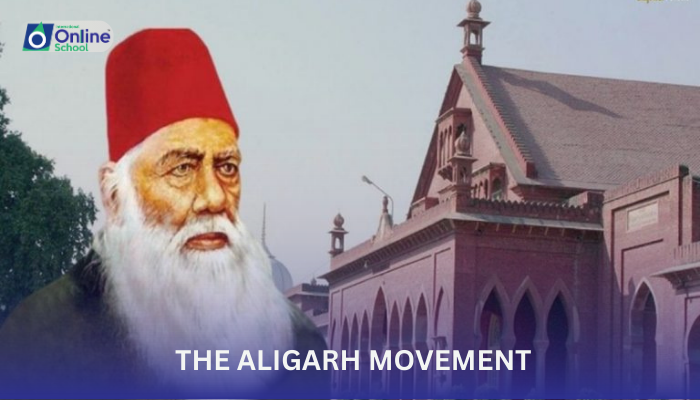
Background of the Aligarh Movement
Indian authority was shifted from the Muslim to the British hands, as a result of the failure of the War of Independence in 1857. This great debacle shook the entire structure of South Asia's, Social and political life to the depth of its roots. This course of events gave birth to a person like Sir Sayyid Ahmad Khan. Sir Sayyad Ahmad Khan had stood by the side of the British during the "War of Independence" and saved the lives of many English gentlemen and their families. This had not happened accidentally, he had done all this with full commitment. In the changed circumstances Sir Sayyid Ahmad Khan believed, it was not a wise policy for the Muslims to adopt antagonistic attitude towards the new rulers of India and incur their anger. Sir Sayyid Ahmad Khan advised the Muslims to adopt a policy of conciliation and friendship towards the British, abstain form indulging into politics, acquire modern education, try to secure maximum government services and be loyal to the British Government.
Sir Sayyad Ahmad Khan's conciliatory efforts, taken collectively, are known as 'Aligarh Movement'. A large section of the Indian Muslim community appreciated his efforts and stood by his side, while a still larger part did not see eye to eye with him and opposed him bitterly, to them Sir Sayyid Ahmad Khan's policy, would hurt the national and religious pride of the Muslims. Notwithstanding the sincerity of purpose Sir Sayyid Ahmad Khan may have, the opponents believed, following his policy would mean eternal slavery for theMuslims of India.
Objectives of Sir Sayyad's efforts can be summed up in four points
i. To bring about conciliation among the Muslims and the British.
ii. To spread education among the Muslims, impart English language and learning and make the Muslims familiar with the British culture and way of life.
iii. To make the Muslims loyal subjects of the British Government.
iv. To develop friendly and good neighbourly relations between the Muslims and other Indian nations.
Sir Sayyad's Efforts
Sir Sayyad Ahmad Khan took following major steps for the achievement of his objectives:
Causes of Indian Mutiny: In 1859 Sir Sayyid wrote a book titled "Asbab-e- Baghawat-e-Hind", especially meant for reading by the members of the British Parliament. In this book he tried to prove that the uprising of 1857 was, by no means, a war of independence, this was just an upheaval spurred by a few trouble mongers. He said that certain unwise policies of the British Government also paved way for the unrest that resulted in this unfortunate incident. The Muslims, generally, liked to label the 1857 events as "War of Independence", but Sir Sayyid always called it a mutiny.
The Loyal Muhammadans of India: In the year 1860 Sir Sayyid magazine under the title of "Loyal Muhammadans of India". In this magazine he started highlighting the services of those Muslim nobles who had put their lives in danger to save the lives of the British officials and citizens during 1857 upheaval.
Some other Reconciliatory Efforts: In order to bring the British rulers and the Muslims closer to each other, Sir Sayyad wrote a number of books and tracts, most notable among these were:
Tehqiq-e-lafz-e-Nasara, Tabein-ul-Kalam (a commentary of the Bible). Risala- Ehkam-e-Toam-e-Ahl-e-Kitab, and Aligarh Institute Gazette.
Establishment of Schools: During the days of his service Sir Sayyad instituted schools at different places i.e. Murad Abad (1859), Ghazipur (1862).
Establishment of the Scientific Society: In 1863 Sir Sayyid launched an institution with the purpose of translating important scholarly works from English to Urdu; he gave it the name of "Scientific Society".
Study of the British Education System: Sir Sayyad visited England in the year 1869. He made good use of this opportunity by visiting the most prestigious of the British educational institutions. He made a deep study of the curriculum of these institutions, and on his return to India, established a committee named "Khawastgaran-e-Traqi-e-Taleem-e-Musalmanaan-e-Hind". Sole purpose of this committee was to establish educational institutions in India, conforming to the British standards.
Establishment of the MAO Schools: As the first step the committee Khawastgaran-e-Taraqi-e-Taleem-e-Musalmanaan-e-Hind established a school at Aligarh in the year 1875 it was named, Muhammadan Anglo Oriental School. 8. Establishment of the MAO College: The MAO School was upgraded to the level of college in the year 1877. Viceroy Lord Lyton laid the foundation stone of the College and donated a sum of Rupees ten thousand from his own purse.
Establishment of the Muhammadan Educational Conference: To motivate the Muslims for acquiring modern knowledge Sir Sayyad established Muhammadan Educational Conference in the year 1886. Annual meetings of the Conference were held at different important places throughout India. The Muslim League was founded in 1906, in an annual meeting of the Conference held at Dacca.
Political Services and the Two Nations Theory: Sir Sayyad's services in the field of politics are highly meritorious, following two are the most significant:
- As a member of the Imperial Legislative Council he took up the Indian problems very effectively with the Indian Government.
- In the year 1867 the Hindus of Banaras launched a movement to demand that Urdu should be replaced by Hindi as official language. Sir Sayyad who was a great protagonist of Hindu-Muslim unity got utterly disappointed at this unfriendly gesture. His demand for separate electorate was a direct corollary of such Hindu overtures. He demanded that the member of Muslim seats in the Viceroy's Council should be fixed; the Hindu voters should elect Hindu members, while the Muslim members should be elected only by the Muslim voters.